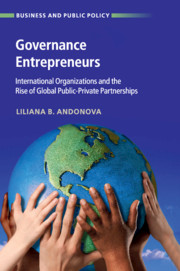35 results
10 - Clean Energy and the Hybridization of Global Governance
-
-
- Book:
- Global Governance in a World of Change
- Published online:
- 02 December 2021
- Print publication:
- 09 December 2021, pp 288-310
-
- Chapter
-
- You have access
- Open access
- HTML
- Export citation
15 - Transferring Technologies
- from Part IV - Substantive Governance Challenges
-
-
- Book:
- Governing Climate Change
- Published online:
- 04 May 2018
- Print publication:
- 03 May 2018, pp 266-284
-
- Chapter
-
- You have access
- Open access
- HTML
- Export citation
Acknowledgments
-
- Book:
- Governance Entrepreneurs
- Published online:
- 31 October 2017
- Print publication:
- 02 November 2017, pp ix-xii
-
- Chapter
- Export citation
3 - The UN Secretariat
-
- Book:
- Governance Entrepreneurs
- Published online:
- 31 October 2017
- Print publication:
- 02 November 2017, pp 67-107
-
- Chapter
- Export citation
5 - Partnerships for Children and Health
-
- Book:
- Governance Entrepreneurs
- Published online:
- 31 October 2017
- Print publication:
- 02 November 2017, pp 145-192
-
- Chapter
- Export citation
6 - Conclusion
-
- Book:
- Governance Entrepreneurs
- Published online:
- 31 October 2017
- Print publication:
- 02 November 2017, pp 193-211
-
- Chapter
- Export citation
Bibliography
-
- Book:
- Governance Entrepreneurs
- Published online:
- 31 October 2017
- Print publication:
- 02 November 2017, pp 223-264
-
- Chapter
- Export citation
1 - Introduction – Global Partnerships
-
- Book:
- Governance Entrepreneurs
- Published online:
- 31 October 2017
- Print publication:
- 02 November 2017, pp 1-32
-
- Chapter
- Export citation
Annex - Constructing the Global Partnerships Database
-
- Book:
- Governance Entrepreneurs
- Published online:
- 31 October 2017
- Print publication:
- 02 November 2017, pp 212-222
-
- Chapter
- Export citation
4 - UNEP and the World Bank
-
- Book:
- Governance Entrepreneurs
- Published online:
- 31 October 2017
- Print publication:
- 02 November 2017, pp 108-144
-
- Chapter
- Export citation
Index
-
- Book:
- Governance Entrepreneurs
- Published online:
- 31 October 2017
- Print publication:
- 02 November 2017, pp 265-276
-
- Chapter
- Export citation
Copyright page
-
- Book:
- Governance Entrepreneurs
- Published online:
- 31 October 2017
- Print publication:
- 02 November 2017, pp iv-iv
-
- Chapter
- Export citation
Figures
-
- Book:
- Governance Entrepreneurs
- Published online:
- 31 October 2017
- Print publication:
- 02 November 2017, pp vi-vii
-
- Chapter
- Export citation
Contents
-
- Book:
- Governance Entrepreneurs
- Published online:
- 31 October 2017
- Print publication:
- 02 November 2017, pp v-v
-
- Chapter
- Export citation
Tables
-
- Book:
- Governance Entrepreneurs
- Published online:
- 31 October 2017
- Print publication:
- 02 November 2017, pp viii-viii
-
- Chapter
- Export citation
2 - Theory of Dynamic Institutional Change
-
- Book:
- Governance Entrepreneurs
- Published online:
- 31 October 2017
- Print publication:
- 02 November 2017, pp 33-66
-
- Chapter
- Export citation

Governance Entrepreneurs
- International Organizations and the Rise of Global Public-Private Partnerships
-
- Published online:
- 31 October 2017
- Print publication:
- 02 November 2017
1 - Introducing Transnational Climate Change Governance
-
- Book:
- Transnational Climate Change Governance
- Published online:
- 05 August 2014
- Print publication:
- 21 July 2014, pp 1-16
-
- Chapter
- Export citation
4 - Origins, Agency and the Forms of Transnational Climate Change Governance
-
- Book:
- Transnational Climate Change Governance
- Published online:
- 05 August 2014
- Print publication:
- 21 July 2014, pp 61-88
-
- Chapter
- Export citation
2 - Mapping the World of Transnational Climate Change Governance
-
- Book:
- Transnational Climate Change Governance
- Published online:
- 05 August 2014
- Print publication:
- 21 July 2014, pp 17-37
-
- Chapter
- Export citation



